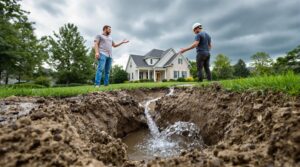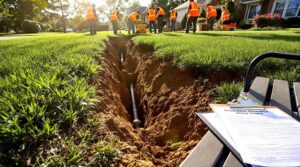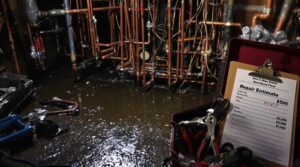Homeowners insurance typically covers underground water leaks that are sudden and accidental. Coverage may include damage from burst pipes or water main breaks, with limits ranging from a few thousand dollars to over $100,000. However, exclusions often apply to leaks caused by poor maintenance, wear and tear, or pre-existing conditions. Policy specifics vary by insurer, and understanding these terms is essential for managing expectations. Further exploration of policy details and exclusions can provide clarity on what is covered.
Key Takeaways
- Homeowners insurance typically covers sudden and accidental underground water leaks, such as burst pipes or water main breaks.
- Exclusions like poor maintenance, wear and tear, and pre-existing conditions are often not covered by homeowners insurance.
- Policy limits for underground water leak coverage vary, ranging from a few thousand dollars to over $100,000.
- Prompt detection and documentation of the leak are crucial for filing a successful insurance claim.
- Regular maintenance and inspections can help prevent underground water leaks and ensure coverage in case of damage.
Understanding the Risks and Impacts of Underground Water Leaks
Underground water leaks pose a significant threat to homes and properties, often causing extensive damage before being detected. These leaks can originate from various sources, including pipes, appliances, and even cracks in the foundation of the building. Homeowners may be unaware of the leak until signs of water damage appear, such as warped flooring, sagging ceilings, or mold growth.
The severity of underground water leaks is often exacerbated by delayed leak detection. Due to the hidden nature of these leaks, the extent of the damage can be extreme before homeowners recognize the issue. Prompt detection is essential to minimize the amount of water damage sustained by the property. Early identification and addressing of underground water leaks can prevent significant financial burdens and preserve the structural integrity of the home. Efficient leak detection and resolution methods are essential for mitigating these risks. Regular inspections can aid in early identification.
Types of Underground Water Leaks Covered by Homeowners Insurance
Homeowners insurance policies often provide coverage for specific types of underground water leaks, which can help alleviate the financial burden associated with these events. Typically, coverage is offered for sudden and accidental leaks resulting from a one-time occurrence, such as a burst pipe or damage from a fallen tree. Leak types including water main breaks, plumbing pipe ruptures, and septic system failures often qualify for coverage. Homeowners should review their policy documents to determine the specific leak types included in their coverage and applicable coverage limits. Limits often range from a few thousand dollars to $100,000 or more per occurrence, depending on the policy terms. To maximize reimbursement, policyholders must document the occurrence and demonstrate its sudden and accidental nature. A thorough understanding of covered leak types and limits is critical to making informed decisions about claim submissions and optimizing policy benefits. Coverage specifics vary by insurer and policy. Regular maintenance records can support water leak claims and potentially lead to lower insurance premiums over time.
When Homeowners Insurance Does Not Cover Underground Water Leaks
While insurance coverage can provide financial relief for certain types of underground water leaks, there are instances where homeowners insurance policies do not offer protection. Homeowners insurance policies typically include an exclusions policy that outlines specific situations where coverage is not applicable. Underground water leaks caused by poor maintenance, wear and tear, or gradual deterioration are often excluded from coverage. Homeowners are expected to perform regular maintenance responsibilities to prevent such issues. If a leak is attributed to a lack of maintenance or neglect, the insurance company may deny the claim. Additionally, if the leak is deemed a pre-existing condition or a normal part of the home's settling process, coverage may also be denied. It is essential for homeowners to review their policy and understand the exclusions to avoid unexpected expenses. By doing so, they can better manage their expectations and plan accordingly to mitigate potential financial losses. Similar to how only 27% of homeowners in flood-prone areas maintain flood insurance, many property owners overlook the importance of understanding their policy's water damage coverage limitations.
Detecting and Preventing Underground Water Leaks
Because the majority of underground water pipes are concealed from view, detecting leaks can be a difficult task, often relying on indirect signs such as an unexpected increase in the water bill, visible water damage, or the presence of water spots on floors and ceilings. Effective leak detection requires a combination of vigilance and technical expertise. Homeowners can utilize various tools and techniques to identify potential leaks before they cause significant damage.
Some methods for detecting and preventing underground water leaks include:
- Monitoring water usage patterns to detect unusual spikes in consumption
- Conducting regular visual inspections of pipes and fixtures
- Installing leak detection systems that alert homeowners to potential issues
- Implementing prevention methods such as pipe insulation and corrosion protection
- Scheduling regular maintenance with a licensed plumber to inspect and maintain underground pipes
Filing a Claim for Underground Water Leak Damage With Your Insurer
Upon discovery of an underground water leak, prompt action is necessary to mitigate damage and initiate the insurance claims process. Homeowners should notify their insurer as soon as possible to begin the claim process.
| Claim Process Steps | Insurer Communication |
|---|---|
| 1. Notify insurer of the leak | Phone call or online claim submission |
| 2. Provide documentation of damage | Photos, videos, and repair estimates |
| 3. Complete a claim form | Insurer-provided form or online portal |
| 4. Wait for insurer assessment | Adjuster inspection and damage evaluation |
| 5. Receive claim settlement | Payment for approved damages and repairs |
Throughout the claim process, maintaining open communication with the insurer is essential. Homeowners should keep detailed records of correspondence, including dates, times, and conversation details. This helps guarantee a smooth and efficient claim resolution, allowing homeowners to recover from the damage caused by the underground water leak. Consulting with public insurance adjusters can be particularly beneficial for maximizing property damage settlements in complex water damage scenarios.








